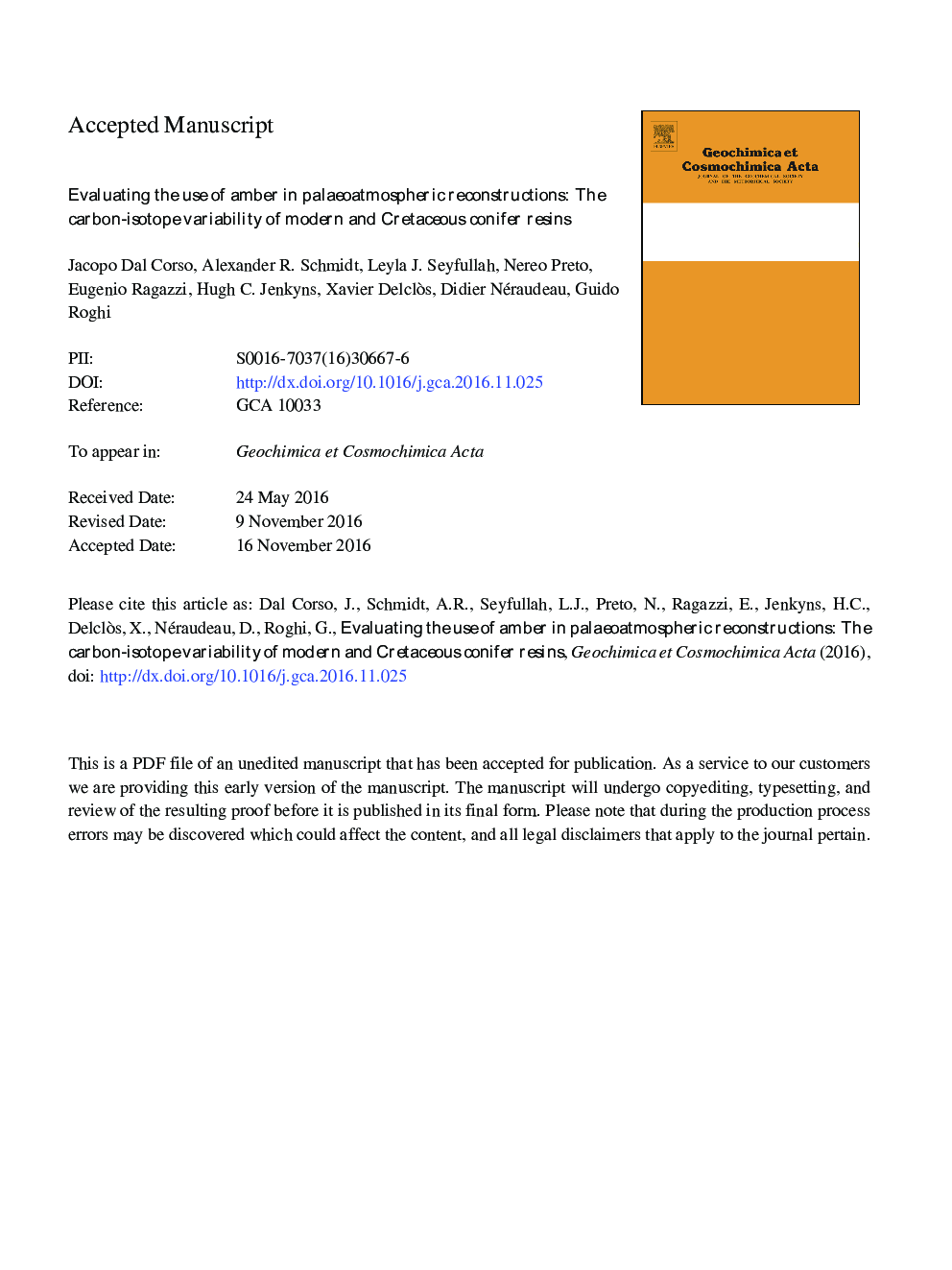| کد مقاله | کد نشریه | سال انتشار | مقاله انگلیسی | نسخه تمام متن |
|---|---|---|---|---|
| 5783379 | 1637958 | 2017 | 51 صفحه PDF | دانلود رایگان |
عنوان انگلیسی مقاله ISI
Evaluating the use of amber in palaeoatmospheric reconstructions: The carbon-isotope variability of modern and Cretaceous conifer resins
ترجمه فارسی عنوان
ارزیابی استفاده از کهربا در بازسازی های پلاسماسفری: تغییرات ایزوتوپ کربن از رزین های مخروطی مدرن و کرتاسه
دانلود مقاله + سفارش ترجمه
دانلود مقاله ISI انگلیسی
رایگان برای ایرانیان
کلمات کلیدی
رزین مخروطی، کهربا، ایزوتوپهای کربن، پائئوسکلیمات، کرتاسه،
موضوعات مرتبط
مهندسی و علوم پایه
علوم زمین و سیارات
ژئوشیمی و پترولوژی
چکیده انگلیسی
Stable carbon-isotope geochemistry of fossilized tree resin (amber) potentially could be a very useful tool to infer the composition of past atmospheres. To test the reliability of amber as a proxy for the atmosphere, we studied the variability of modern resin δ13C at both local and global scales. An amber δ13C curve was then built for the Cretaceous, a period of abundant resin production, and interpreted in light of data from modern resins. Our data show that hardening changes the pristine δ13C value by causing a 13C-depletion in solid resin when compared to fresh liquid-viscous resin, probably due to the loss of 13C-enriched volatiles. Modern resin δ13C values vary as a function of physiological and environmental parameters in ways that are similar to those described for leaves and wood. Resin δ13C varies between plant species and localities, within the same tree and between different plant tissues by up to 6â°, and in general increases with increasing altitudes of the plant-growing site. We show that, as is the case with modern resin, Cretaceous amber δ13C has a high variability, generally higher than that of other fossil material. Despite the high natural variability, amber shows a negative 2.5-3Ⱐδ13C trend from the middle Early Cretaceous to the Maastrichtian that parallels published terrestrial δ13C records. This trend mirrors changes in the atmospheric δ13C calculated from the δ13C and δ18O of benthic foraminiferal tests, although the magnitude of the shift is larger in plant material than in the atmosphere. Increasing mean annual precipitation and pO2 could have enhanced plant carbon-isotope fractionation during the Late Cretaceous, whereas changing pCO2 levels seem to have had no effect on plant carbon-isotope fractionation. The results of this study suggest that amber is a powerful fossil plant material for palaeoenvironmental and palaeoclimatic reconstructions. Improvement of the resolution of the existing data coupled with more detailed information about botanical source and environmental growing conditions of the fossil plant material will probably allow a more faithful interpretation of amber δ13C records and a wider understanding of the composition of the past atmosphere.
ناشر
Database: Elsevier - ScienceDirect (ساینس دایرکت)
Journal: Geochimica et Cosmochimica Acta - Volume 199, 15 February 2017, Pages 351-369
Journal: Geochimica et Cosmochimica Acta - Volume 199, 15 February 2017, Pages 351-369
نویسندگان
Jacopo Dal Corso, Alexander R. Schmidt, Leyla J. Seyfullah, Nereo Preto, Eugenio Ragazzi, Hugh C. Jenkyns, Xavier Delclòs, Didier Néraudeau, Guido Roghi,
